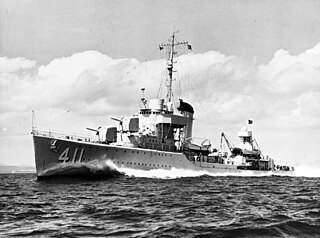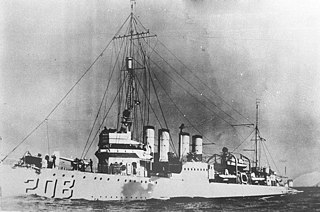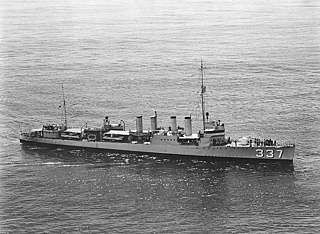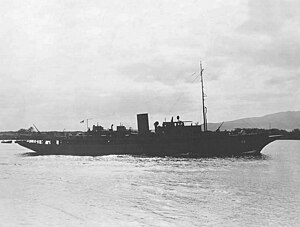
USS Yorktown (CV-5) was an aircraft carrier that served in the United States Navy during World War II. Named after the Battle of Yorktown in 1781, she was commissioned in 1937. Yorktown was the lead ship of the Yorktown class, which was designed on the basis of lessons learned from operations with the converted battlecruisers of the Lexington class and the smaller purpose-built USS Ranger.

USS Wasp (CV-7) was a United States Navy aircraft carrier commissioned in 1940 and lost in action in 1942. She was the eighth ship named USS Wasp, and the sole ship of a class built to use up the remaining tonnage allowed to the U.S. for aircraft carriers under the treaties of the time. As a reduced-size version of the Yorktown-class aircraft carrier hull, Wasp was more vulnerable than other United States aircraft carriers available at the opening of hostilities. Wasp was initially employed in the Atlantic campaign, where Axis naval forces were perceived as less capable of inflicting decisive damage. After supporting the occupation of Iceland in 1941, Wasp joined the British Home Fleet in April 1942 and twice ferried British fighter aircraft to Malta.

USS Tulagi (CVE-72) was a Casablanca-class escort carrier of the United States Navy.

USS Aaron Ward (DD-483) was a Gleaves-class destroyer in the service of the United States Navy. She was the second Navy ship named in honor of Rear Admiral Aaron Ward. She sank on 7 April 1943 in a shoal near Tinete Point of Nggela Sule, Solomon Islands during Operation I-Go. Her wreck was discovered on 4 September 1994.

USS Anderson (DD-411) was a Sims-class destroyer in the United States Navy. She was named for Rear Admiral Edwin Alexander Anderson, Jr., a Medal of Honor recipient.

USS Tattnall (DD–125) was a Wickes-class destroyer in the United States Navy during World War II. She was the first ship named for Captain Josiah Tattnall III.

USS Manley (DD-74/AG-28/APD-1), a Caldwell-class destroyer, served in the United States Navy. She was the second Navy ship named for Captain John Manley (c.1733–1793).

USS Goldsborough (DD-188/AVP-18/AVD-5/APD-32) was a Clemson-class destroyer in the United States Navy during World War II. She was the second Navy ship named for Rear Admiral Louis M. Goldsborough (1805–1877). Entering service in 1920, the ship had a brief active life before being placed in reserve in 1922. Goldsborough was reactivated for World War II and was used as an aircraft tender, destroyer and high speed transport in both Atlantic and Pacific theaters. Following the war, the ship was sold for scrapping in 1946.

USS Hovey (DD-208/DMS-11) was a Clemson-class destroyer in the United States Navy during World War II. She was the only ship named for Ensign Charles Hovey (1885–1911).

USS Kearny (DD-432), a Gleaves-class destroyer, was a United States Navy warship during World War II. She was noted for being torpedoed by a German U-boat in October 1941, before the U.S. had entered the war. She survived that attack, and later served in North Africa and the Mediterranean.

USS Tillman (DD-641), a Gleaves-class destroyer, was the second ship of the United States Navy to be named for United States Senator Ben Tillman. In commission from 1942 to 1947, she saw service in World War II, primarily in the Atlantic and Mediterranean.

USS Zane (DD-337/DMS-14/AG-109) was a Clemson-class destroyer in the United States Navy following World War I. She was named for Randolph Zane.

USS Tatum (DE-789/APD-81) was a Buckley-class destroyer escort in service with the United States Navy from 1944 to 1946. She was scrapped in 1960.

USS Jamestown (PG-55) was a patrol gunboat and after 13 January 1943 a Jamestown-class motor torpedo boat tender acquired by the U.S. Navy during World War II. Her task in her final classification was to provide a "home base" for torpedo boats in remote parts of the ocean during the war, and to provide them with necessary services, such as fuel, food, and repairs.

The second USS Barnegat (AVP-10), in commission from 1941 to 1946, was the lead ship of her class of small seaplane tenders built for the United States Navy just before and during World War II. She was the second U.S. Navy ship to bear that name.

The second USS Willoughby (AGP-9) was a motor torpedo boat tender that served in the United States Navy from 1944 to 1946, seeing service in the later stages of World War II. Transferred to the United States Coast Guard in 1946, she was in commission as the cutter USCGC Gresham (WAVP-387), later WHEC-387 and WAGW-387, from 1947 to 1969 and from 1970 to 1973, seeing service in the Vietnam War during her Coast Guard career.

USS Half Moon (AVP-26) was a seaplane tender that in commission in the United States Navy from 1943 to 1946 that saw service in the latter half of World War II. After the war, she was in commission in the United States Coast Guard as the cutter USCGC Half Moon (WAVP-378), later WHEC-378, from 1948 to 1969, seeing service in the Vietnam War during her Coast Guard career.

USS Orestes (AGP-10) was a motor torpedo boat tender that served in the United States Navy from 1944 to 1946.

USS Varuna (AGP-5) was a Portunus-class motor torpedo boat tender of the United States Navy during World War II.

USS Acontius (AGP-12) was a motor torpedo boat tender in service with the United States Navy from 1944 to 1946. She was scrapped in 1965.





















